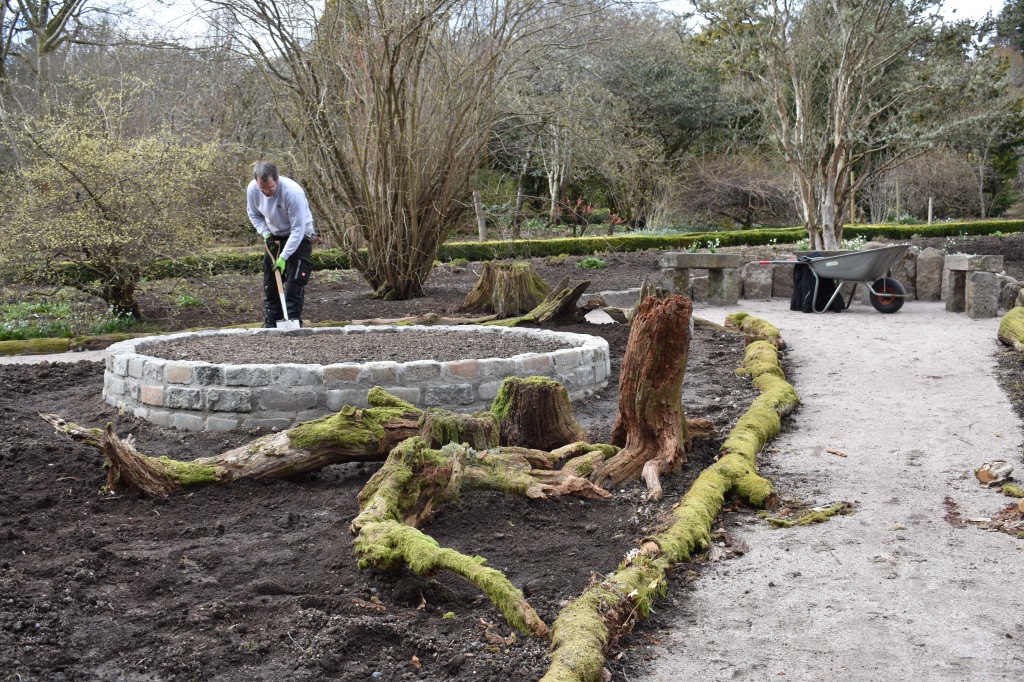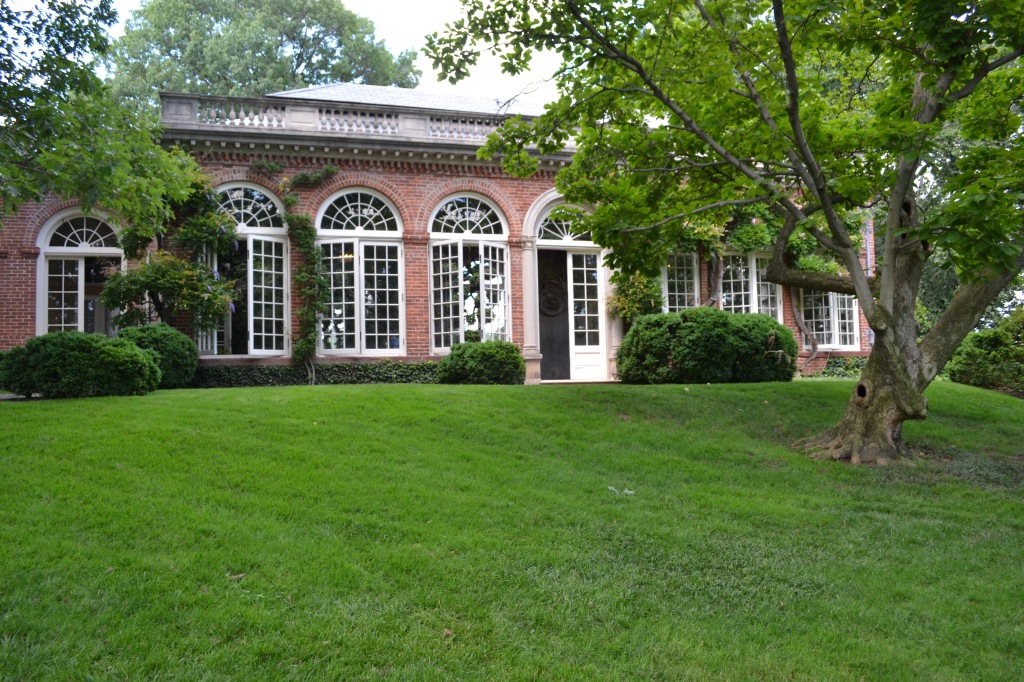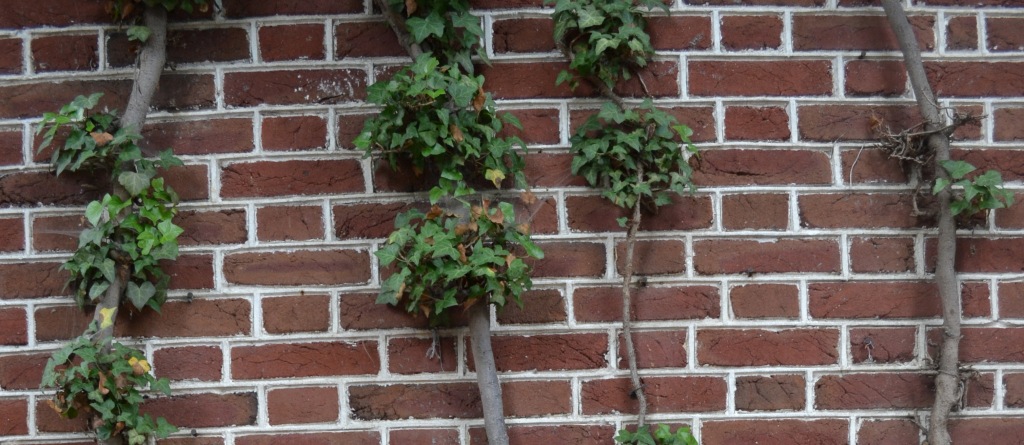
We live in surreal times and being unable to visit our favourite places is of minor importance in the scheme of things, but I will not be the only person missing Crathes. Gardens, however, go on growing regardless. I am keeping in touch with the James, the Head Gardener, as much as possible, and ten years of photographs will help to keep Notes from Crathes relevant. For immediacy I might add some notes from Torphins (about seven miles from Crathes) my home village. James reports that only he and Andy are now working in the garden; they both live on site. They work in shifts to keep the glasshouses and poly tunnels watered and in order. There are seedlings and cuttings to pot on; plant plugs ordered which will all need to be potted on and bulbs and cyclamens that are finished for this year and need to be moved. Biological controls are expected shortly as the temperature rises. Weeding, grass cutting and project work has all stopped meantime as priority is given to caring for the plants that will be needed when the visitors return.
I did manage to visit Crathes, taking care to follow social distancing advice, on 19 March just before the lockdown. It was glorious day: a light frost in the morning followed by warm sunshine. Birdsong rang out across the garden accompanied by the buzzing of bees on the lungworts and chionodoxas. The garden was just about ready to meet the season. It was a perfect spring day.
The Stachyurus praecox was looking pretty good and it too had visiting bees – both honey and bumble. It hails from Japan. Further along on the Aviary Terrace is the Drimys lanceolata from Tasmania. The flowers, which are small and fluffy, were not quite opened, but it’s all I’ll get to see this year. The red stems contrast well with the dark green leaves. It has a lovely scent when fully in flower.


You won’t be surprised to hear that pruning has continued: The rose ‘Snowdrift’ on the Woodland Garden gate was all trim and shipshape; Mike and Steve were working on the White Border and Tim was busy pruning the climbers in the Upper Pool Garden.


James and Andy had time to get back to the Evolution Garden. The hard landscaping is almost done. Mossy stumps have been brought in from the estate.



Out in the Woodland Garden Davy was fixing the fence, which had never been properly buried, to keep the rabbits out.

The blue of the chionodoxas and scillas at my feet echoed the blue sky above. This year it is creeping into the Golden Garden. I smile at the rebellious disruption of the colour scheme. Red and pink Japanese quinces – Chaenomeles species – compliment the dusty pink bricks of the wall below the Aviary Terrace.



Iris stylosa (syn. unguicularis) ‘Mary Barnard’ was amongst the flowers that attracted my attention, growing against the glasshouse wall. Often the flowers are few and far between but their fragile beauty in the winter months is always a joy. Mary Barnard (1909-2001), I find from Google, was an American poet – particularly known for her translation of the works of Sappho.
There are lots of horticultural names emanating from Forsythia x intermedia ‘Beatrix Farrand’ which grows in the Golden Garden. Forsythia honours William Forsyth (c.1737-1804) who was born in Old Meldrum which is not so far from here. The Dictionary of National Biography (2004) suggests he ‘probably served his apprenticeship with Lord Aberdeen at Haddo House’. There were certainly many large houses quite close to Old Meldrum at the time – Fyvie and Pitmedden to name a couple – where he could have received his training. After his apprenticeship Forsyth went south and worked under Philip Miller at the Chelsea Physic Garden. In 1763 he was appointed head gardener to the Duke of Northumberland at Syon House – the grand estate on the opposite side of the Thames to Kew Gardens. He must have been there about the time that Capability Brown was transforming the grounds. By 1771 he was back at the Chelsea Physic Garden as superintendent. His final move was in 1784 to be superintendent of the gardens of St James’s and Kensington Palace (the Royal Parks). William Forsyth was one of the founders of the Royal Horticultural Society.

Beatrix Farrand (1872-1959), the great American garden designer, I know of already because I was fortunate enough to visit Dumbarton Oaks, Washington DC, once the home of Robert and Mildred Bliss. Mildred and Beatrix worked together on the garden at Dumbarton Oaks for decades. Beatrix Jones, of a wealthy American family, travelled in Europe, including Scotland, before training in horticulture at the Arnold Arboretum in Boston under Charles Sprague Sargent. (Sargent is another name that appears on some of our shrubs – Viburnum sargentii ‘Onondaga’ for example.) She later married Dr Max Farrand and they moved to California. Beatrix was much influenced by Gertrude Jekyll. Indeed it is an interesting story, told to me by Lester Borley, that Beatrix and her mother attended the sale of Jekyll’s effects at Munstead Wood, but were unable to purchase anything. Strolling round the garden they discovered discarded papers piled up beside the bins. Investigating they found they were some of Jekyll’s garden plans, which they then purchased. The plans are now in the archives of the University of California in Berkeley. In her seventies Beatrix Farrand produced a plant book for Dumbarton Oaks, listing all the plants grown in the various parts of the garden with instructions on their care. The plant listings with an accompanying history of the garden is on my bookshelf. I don’t remember visiting the forsythia dell and if I did it would have been rather dull in July, but a photograph in the book shows an amazing mass of forsythias in a photograph taken in 1959. Few gardens could devote so much space to the short spring flush. Seventeen acres of the garden were gifted to Harvard in 1941; some more were given to the National Parks.








We didn’t have enough time to visit all of the garden or to grasp the intricacy of the design. Regretfully I could only view the vegetable garden with its two pavilions from an upper terrace. You can see from the photographs how important the terracing is to the overall design.

The ‘x intermedia’ part of the name indicates a plant is developed from two species. The development of the cultivar Beatrix Farrand and its subsequent history is complicated and I have rambled on enough – I refer those who are further interested to WJ Bean’s Trees and Shrubs Hardy in the British Isles (Volume II 1980-81).
Before leaving Crathes on 19 March I had a last look in the glasshouses. I didn’t go in because of the social distance advice. The scent of hyacinths was pouring out of the open windows. The worry about the main show going over before Easter already seemed irrelevant, but I didn’t realise then that I would not be able to return for months to come.

Take care everyone.
Hello Sue – please keep the posts coming … I am pining for Crathes already and am looking forward to seeing it again in person, meantime your beautiful photographs and posts will keep me going. Gardens like Crathes are precious. Are there any opportunities for a web cam (or web cams) to be installed so we can all keep an eye on the garden whilst unable to go into it – this of course applies to all NTS gardens!
LikeLiked by 1 person
Thanks Sandra. The webcam issue is probably not practical at the moment.
LikeLike
Thank you for another fascinating article and a refreshing look at Crathes – I look forward to seeing more of the evolutionary garden!
LikeLiked by 1 person
Thank you Jenny. We will have to wait a while – all projects are on hold.
LikeLike